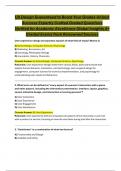UX Design Guaranteed to Boost Your Grades Unlock
Success Expertly Crafted Graded Questions
Verified for Academic Excellence Global Insights A+
Graded Exams from Renowned Sources
User experience design incorporates aspects of what field of study? (Name 3)
A) Game Design, Computer Science, Psychology
B) Marketing, Economics, Art
C) Sociology, Philosophy, Biology
D) Journalism, History, Chemistry
Correct Answer: A) Game Design, Computer Science, Psychology
Rationale: User experience design draws from various fields, particularly those that
explore human behavior, interaction, and technology, such as game design for
engagement, computer science for technical implementation, and psychology for
understanding user needs and behaviors.
2. What term can be defined as "every aspect of a person's interaction with a game
and other players, including the information presentation, interface, layout, graphics,
sound, industrial design, and interaction or learning process"?
A) User Interaction
B) User Experience
C) User Engagement
D) User Satisfaction
Correct Answer: B) User Experience
Rationale: User experience (UX) encompasses all aspects of the interaction a user has
with a product or service, focusing on how the user feels during and after the interaction.
3. "Usefulness" is a combination of what two factors?
A) Functionality and Design
B) Usability and Utility
,C) Efficiency and Effectiveness
D) Accessibility and Satisfaction
Correct Answer: B) Usability and Utility
Rationale: Usefulness refers to how well a product meets the needs of the user (utility) and
how easy it is to use (usability), both of which are essential for a positive user experience.
4. Name the three types of affordances.
A) Perceptible, False, and Hidden Affordances
B) Physical, Psychological, and Visual Affordances
C) Explicit, Implicit, and Verbal Affordances
D) Contextual, Temporal, and Spatial Affordances
Correct Answer: A) Perceptible, False, and Hidden Affordances
Rationale: Affordances are the qualities of an object that suggest how it can be used.
Perceptible affordances are visible, false affordances mislead users, and hidden
affordances are not immediately obvious.
5. What acts as a good reminder of what can be done and allows a control to specify
how the action is to be performed?
A) Feedback
B) Visibility
C) Affordance
D) Mapping
Correct Answer: B) Visibility
Rationale: Visibility refers to how easily users can see what actions are possible at any
moment, which helps them understand how to interact with a system or interface.
6. What is the term that describes the relationship between controls and their
movements and the results in the world?
A) Feedback
B) Affordance
C) Mapping
D) Visibility
, Correct Answer: C) Mapping
Rationale: Mapping refers to the relationship between controls and their effects in the real
world, making it easier for users to predict the results of their actions.
7. What are the two primary sources for mappings?
A) Physical Analogies and Cultural Standards
B) Visual Design and Interaction Design
C) Feedback Mechanisms and User Inputs
D) Technological Constraints and User Preferences
Correct Answer: A) Physical Analogies and Cultural Standards
Rationale: Mappings can derive from physical analogies (how controls are related to real-
world actions) and cultural standards (conventional meanings assigned to certain actions).
8. The process of sending information back to the player about what action has
actually been done or what result has been accomplished is known as what?
A) Visibility
B) Feedback
C) Affordance
D) Response
Correct Answer: B) Feedback
Rationale: Feedback provides users with information about the results of their actions,
which is critical for understanding the impact of their interactions.
9. Name the four types of constraints.
A) Physical Constraints, Semantic Constraints, Cultural Constraints, and Logical
Constraints
B) Technical Constraints, Design Constraints, User Constraints, and Environmental
Constraints
C) Cognitive Constraints, Emotional Constraints, Behavioral Constraints, and Physical
Constraints
D) Functionality Constraints, Usability Constraints, Performance Constraints, and Security
Constraints




